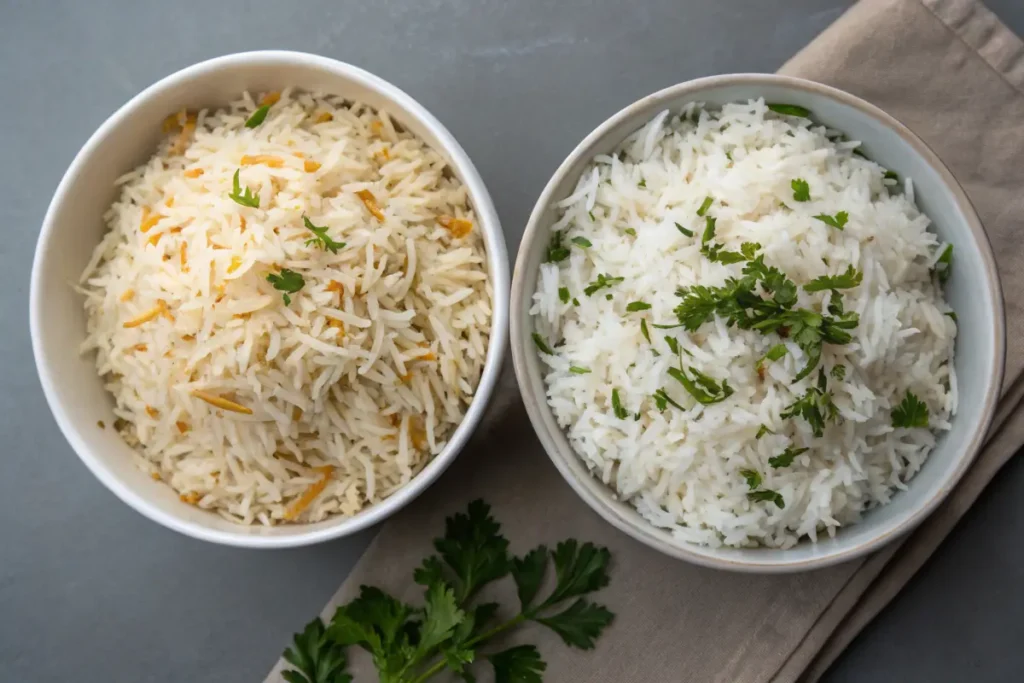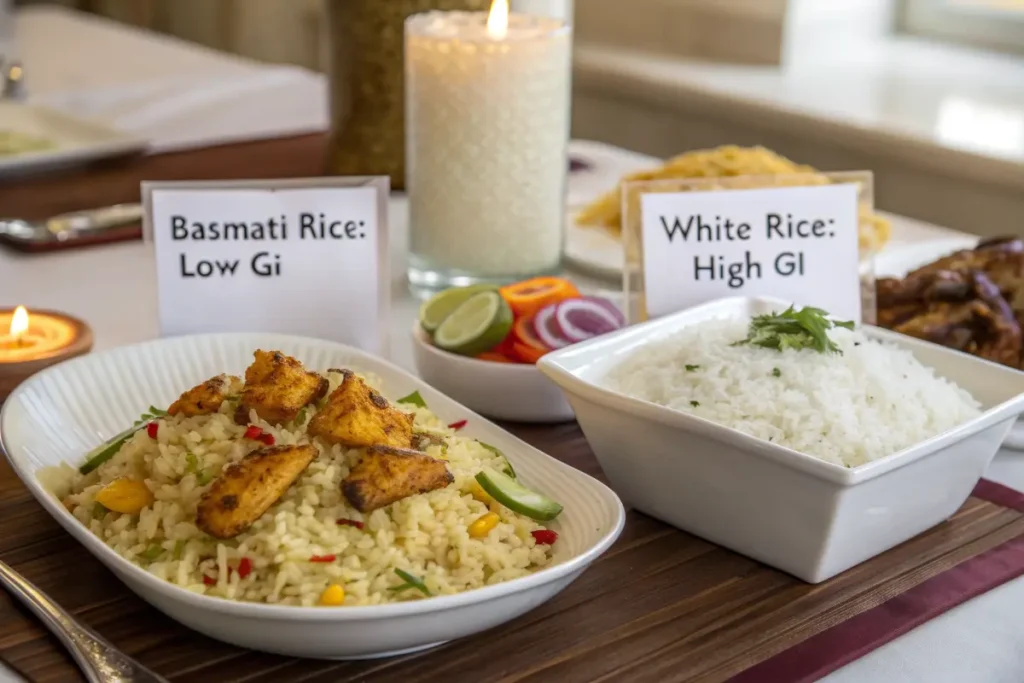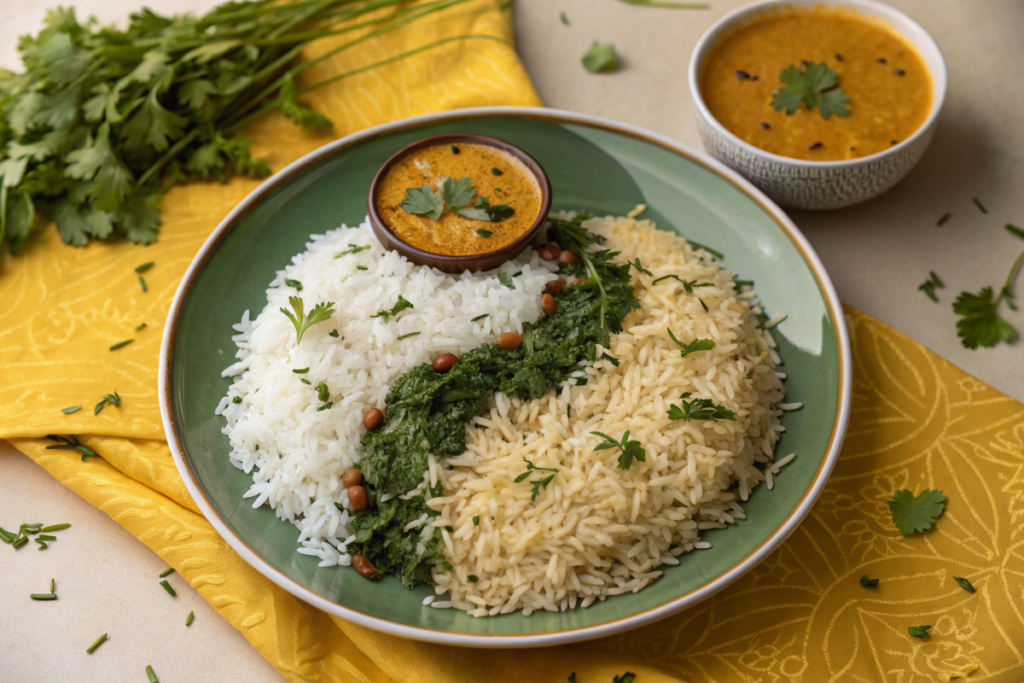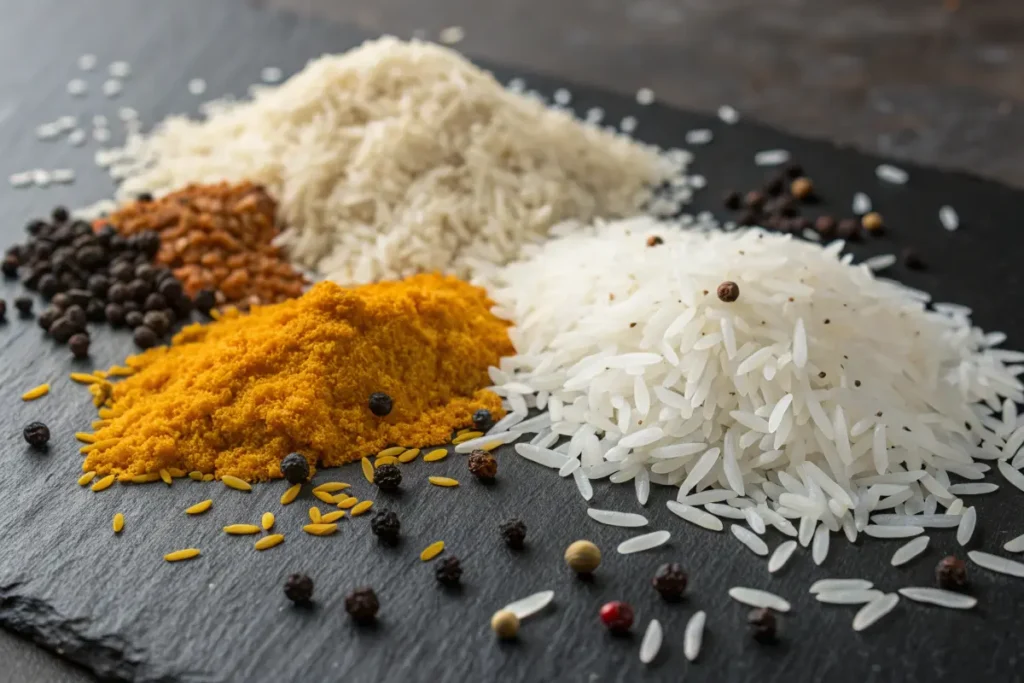Introduction
Basmati rice and white rice are two popular staples found in kitchens worldwide, but one question often arises: Is basmati rice healthier than white rice? While they might seem similar at first glance, these two types of rice differ significantly in their nutritional profiles, health benefits, and culinary uses. In this article, we’ll explore the key differences to help you decide which rice suits your dietary goals.
Whether you’re looking for a low-glycemic option, a better choice for weight loss, or simply trying to understand the health benefits of basmati rice versus white rice, we’ve got you covered. By the end of this guide, you’ll have a clear answer to this common question.
Table of contents
- Introduction
- What Is the Difference Between Basmati Rice and White Rice?
- Nutritional Comparison Between Basmati Rice and White Rice
- Health Benefits of Basmati Rice
- Health Benefits of White Rice
- Basmati Rice and Its Role in Weight Loss
- Why Basmati Is Better for Diabetics
- Cooking and Flavor Profiles
- Cultural and Culinary Uses of Basmati and White Rice
- Sustainability and Environmental Impact
- FAQs About Basmati Rice vs. White Rice
- Conclusion: Choosing the Right Rice for Your Lifestyle

Is Basmati Rice Healthier Than White Rice?
Rice is one of the most widely consumed staples in the world. Among the many varieties, basmati rice and white rice stand out as two of the most popular choices. However, people often ask: Is basmati rice healthier than white rice?
The answer depends on their nutritional value, health benefits, and culinary uses. Basmati rice, with its nutty flavor and low glycemic index, appeals to those seeking a healthy option. Meanwhile, white rice offers a softer texture and neutral flavor, making it a versatile choice for many recipes. By comparing these two types of rice, you can make a decision that aligns with your diet and preferences.
What Is the Difference Between Basmati Rice and White Rice?
Basmati rice and white rice might look similar, but their flavors, nutritional profiles, and cooking methods set them apart. Let’s explore what makes each type of rice unique.
Understanding Basmati Rice
Farmers in India and Pakistan grow basmati rice, especially in the Himalayan foothills. This long-grain rice is famous for its floral aroma and nutty flavor. After cooking, its slender grains become light and fluffy, which makes it ideal for biryani, pilaf, and other flavorful dishes.
You can find basmati rice in two main types: brown and white. Brown basmati keeps its outer bran layer, giving it more fiber and nutrients. In contrast, white basmati goes through polishing, which removes the bran but gives it a softer texture. Despite having slightly fewer nutrients, white basmati remains a popular choice for health-conscious diets.
Characteristics of Standard White Rice
People around the world consume white rice more than any other type of rice. Milling removes the husk, bran, and germ layers, turning it into a refined grain. This process makes the rice softer and increases its shelf life, but it also reduces its fiber and nutrient content.
Unlike basmati rice, white rice has a neutral flavor that pairs well with countless dishes. Many chefs use white rice in recipes like fried rice, risotto, and sushi. Its slightly sticky texture also works well in dishes that require starch for binding or creaminess.
Nutritional Comparison Between Basmati Rice and White Rice
When choosing between basmati rice and white rice, understanding their nutritional differences can help you make a healthier choice. Both types provide energy, but their macronutrients and glycemic index vary significantly, affecting how they impact your body.

Calorie Content
Basmati rice and white rice have similar calorie counts, but basmati rice often contains fewer calories per serving. For example, one cup of cooked white rice provides around 205 calories, while the same amount of cooked basmati rice has about 190 calories. While the difference is small, basmati rice may be a better option if you’re monitoring your calorie intake.
Macronutrients: Carbs, Protein, and Fat
Both basmati rice and white rice are primarily carbohydrate-based foods, which make them excellent sources of quick energy. However, basmati rice generally has a slightly lower carb content compared to white rice. For instance, one cup of basmati rice contains about 39 grams of carbs, while white rice has approximately 45 grams.
Protein content is similar between the two, with about 4 grams per serving in both types. Neither basmati nor white rice contains significant amounts of fat, making them low-fat options for meals.
Fiber Content
Basmati rice, especially the brown variety, has a higher fiber content than white rice. A cup of brown basmati rice contains around 3 grams of fiber, while white basmati and standard white rice provide only about 0.5 to 1 gram of fiber. High-fiber foods like brown basmati support digestive health, regulate blood sugar levels, and help you feel full for longer periods.
Vitamins and Minerals
White rice loses many vitamins and minerals during the milling and polishing process. As a result, white rice contains fewer nutrients compared to basmati rice, especially brown basmati. Basmati rice is naturally rich in B vitamins, including thiamine (B1) and niacin (B3), which support energy metabolism. It also contains small amounts of minerals like magnesium, phosphorus, and iron.
Enriched white rice is fortified with some nutrients, such as iron and folic acid, to compensate for nutrient loss. However, brown basmati rice remains the superior option for natural nutrition.
Health Benefits of Basmati Rice
Basmati rice is more than just a flavorful grain; it offers several health benefits that make it a popular choice for those seeking a nutritious diet. Let’s explore why basmati rice stands out as a healthier option compared to white rice.
Low Glycemic Index for Blood Sugar Control
One of the most significant advantages of basmati rice is its low glycemic index (GI). With a GI of around 50-58, basmati rice causes a slower release of glucose into the bloodstream. This gradual release helps maintain steady blood sugar levels, making it an excellent choice for individuals with diabetes or those looking to prevent blood sugar spikes.
In comparison, white rice has a higher glycemic index (around 70-89), which can cause quick spikes in blood sugar. For this reason, basmati rice is often recommended for people who need to manage their blood sugar levels.
Rich in Fiber for Digestive Health
Brown basmati rice, in particular, is a great source of dietary fiber. A single cup of brown basmati rice contains about 3 grams of fiber, compared to less than 1 gram in white basmati or standard white rice. Fiber plays a key role in supporting digestive health by promoting regular bowel movements and preventing constipation.
Additionally, foods rich in fiber keep you feeling full for longer, which can help control hunger and support weight management. If you’re looking for a healthier option that improves digestion, brown basmati rice is an excellent choice.
Health Benefits of White Rice
Although white rice often gets a bad reputation compared to whole grains, it still offers several benefits, especially for certain dietary needs or lifestyles. Here’s why white rice shouldn’t be dismissed entirely.
Quick Source of Energy
White rice provides a quick and easily digestible source of carbohydrates, making it an ideal choice for individuals who need energy fast. Athletes, for instance, often rely on white rice to replenish glycogen stores after workouts. Additionally, its low fiber content makes it gentler on the stomach, which is especially helpful for those recovering from digestive issues.
Easily Digestible for Sensitive Stomachs
The refining process of white rice removes the bran and germ, which makes it easier to digest. This quality is particularly beneficial for individuals with sensitive stomachs or digestive conditions, such as irritable bowel syndrome (IBS). White rice is also commonly recommended as part of the BRAT (bananas, rice, applesauce, toast) diet to help manage diarrhea or gastrointestinal distress.
Which Rice Is Better for Weight Management?
When it comes to weight management, both basmati rice and white rice can play a role in a healthy diet. However, their effects differ due to their nutritional content, calorie density, and how they impact hunger.
Basmati Rice and Its Role in Weight Loss
Basmati rice, especially the brown variety, is an excellent choice for those aiming to lose weight. Its high fiber content promotes satiety, helping you feel full for longer. Additionally, the slower digestion of basmati rice, due to its low glycemic index, prevents rapid spikes in blood sugar levels. This gradual release of energy keeps hunger at bay and reduces cravings.
A single serving of basmati rice typically contains fewer calories than white rice. For example, one cup of cooked basmati rice has around 190 calories, while white rice contains approximately 205 calories per cup. While the difference is small, it can add up over time if you’re counting calories for weight loss.
White Rice: Myths and Facts
Many people believe that white rice is unhealthy or leads to weight gain, but this isn’t always true. White rice can fit into a weight management plan if consumed in moderation and paired with other nutrient-dense foods. Its low fiber content makes it less filling than basmati rice, but this can work to your advantage if you need a quick source of energy before or after exercise.
In fact, some weight loss plans, like the Rice Diet, have successfully used white rice as part of a controlled eating regimen. The key to using white rice for weight management lies in portion control and balancing it with lean proteins and vegetables.
Impact on Blood Sugar Levels
The glycemic index (GI) of rice is an essential factor for individuals who need to manage their blood sugar levels, especially diabetics. Basmati rice and white rice differ significantly in how they affect blood sugar, making one a better option for certain dietary needs.
Why Basmati Is Better for Diabetics
Basmati rice, with its low glycemic index, is often recommended for people with diabetes. A GI score of 50-58 means basmati rice releases glucose slowly, helping to maintain steady blood sugar levels. This slower digestion also reduces the likelihood of insulin spikes, which can contribute to long-term health benefits like improved metabolic health.
In contrast, white rice has a high glycemic index of around 70-89, which means it can cause rapid increases in blood sugar levels. For individuals with diabetes or prediabetes, frequent consumption of white rice may make blood sugar harder to control. As a result, basmati rice is the better choice for maintaining stable blood sugar levels.

The Role of Portion Control with White Rice
Although white rice has a high glycemic index, portion control can make it manageable for blood sugar regulation. Pairing white rice with fiber-rich vegetables, lean proteins, or healthy fats can slow down the absorption of glucose. For example, adding steamed broccoli, grilled chicken, or avocado to your white rice meal can lower its overall glycemic impact.
For diabetics or those watching their blood sugar, limiting white rice to smaller servings (around half a cup) can help reduce the risk of spikes while still enjoying this versatile grain.
Cooking and Flavor Profiles
Basmati rice and white rice differ not only in their nutritional and health benefits but also in their flavor profiles and cooking methods. These differences make each type suitable for specific dishes and cuisines.

Aromatic and Nutty Flavor of Basmati Rice
Basmati rice is prized for its distinct aroma and nutty flavor, which add depth to any dish. During cooking, the grains release a delicate floral scent that enhances its appeal. Basmati rice also has a light, fluffy texture, with grains that remain separate when cooked properly. This makes it a perfect choice for dishes like biryani, pilaf, or even as a standalone side.
Cooking basmati rice is relatively straightforward, but rinsing the grains beforehand is essential. Rinsing removes excess starch and ensures that the grains do not stick together during cooking. Soaking basmati rice for 20-30 minutes before cooking allows the grains to expand fully and results in a softer, fluffier texture.
Neutral Taste of White Rice
White rice, in contrast, has a milder, neutral flavor, making it a versatile option for a wide range of dishes. Its soft and slightly sticky texture works well in recipes that require binding, such as sushi, risotto, or fried rice. Unlike basmati rice, white rice does not have a distinct aroma, allowing it to complement heavily seasoned dishes without overpowering them.
Cooking white rice is simple and quick. Most varieties require a 1:2 rice-to-water ratio, and it cooks evenly without the need for rinsing or soaking. This convenience makes white rice a go-to option for people seeking quick and easy meal preparation.
Cultural and Culinary Uses of Basmati and White Rice
Both basmati rice and white rice hold important roles in cuisines across the globe. Their cultural and culinary uses reflect their origins and flavor profiles.

Traditional Dishes with Basmati Rice
Basmati rice is a staple in South Asian cuisine. It is commonly used in dishes like biryani, pulao, and kheer (a traditional Indian rice pudding). Its long grains and delicate aroma make it a centerpiece in festive meals and special occasions. Basmati rice also pairs well with spicy curries, grilled meats, and lentil-based dishes like dal.
Beyond India and Pakistan, basmati rice is also used in Middle Eastern cuisine, where it serves as a base for dishes like kabsa and Persian-style rice with saffron and herbs.
Global Popularity of White Rice
White rice is a universal staple found in nearly every cuisine. It is the foundation for countless dishes, including Japanese sushi, Chinese fried rice, Spanish paella, and Italian risotto. Its versatility allows it to absorb the flavors of spices, herbs, and sauces, making it an adaptable ingredient for both savory and sweet dishes.
In many cultures, white rice is a symbol of simplicity and sustenance. For example, in Asia, steaming white rice is a daily ritual, while in Latin America, arroz con pollo (rice with chicken) is a comforting classic. Its global appeal lies in its ability to adapt to different cooking styles and flavor profiles.
Sustainability and Environmental Impact
The cultivation of rice has significant environmental implications, and the differences between basmati rice and white rice extend to their farming practices and sustainability. Understanding their environmental impact can help you make an informed and eco-conscious choice.
Growing Practices for Basmati Rice
Basmati rice is primarily grown in the Himalayan foothills of India and Pakistan, where traditional farming methods have been passed down through generations. These regions rely on natural irrigation systems, including snowmelt from the mountains, to water the rice paddies. This reduces the need for excessive water consumption compared to other rice varieties.
Furthermore, basmati rice farming typically involves hand-harvesting, which minimizes the use of heavy machinery and reduces carbon emissions. Many farmers also practice crop rotation, which helps maintain soil fertility and decreases the likelihood of pests and diseases.
However, exporting basmati rice globally involves long-distance shipping, which contributes to carbon emissions. For eco-conscious consumers, sourcing locally grown alternatives, such as U.S.-grown basmati rice, may be a more sustainable option.
Environmental Concerns of White Rice Farming
White rice, on the other hand, is cultivated on a much larger scale and is grown in many countries worldwide, including China, India, and the United States. Its mass production often requires intensive water usage, as rice paddies need to remain flooded for long periods to deter weeds and pests. Unfortunately, this practice can deplete freshwater resources, especially in regions where water is already scarce.
Additionally, flooded rice fields release methane gas, a potent greenhouse gas that contributes to climate change. According to studies, traditional rice farming accounts for up to 10% of global methane emissions. In response, some countries are exploring sustainable rice farming techniques, such as alternate wetting and drying (AWD), which reduce water usage and methane emissions.
While white rice’s large-scale production makes it affordable and accessible, its environmental footprint is higher than that of basmati rice. Choosing sustainably farmed white rice or supporting farmers who use eco-friendly practices can help reduce its environmental impact.
What You Can Do as a Consumer
As a consumer, you can make more sustainable choices when purchasing rice. Look for organic or sustainably certified rice brands, which often follow better environmental practices. Additionally, buying locally grown rice reduces the carbon footprint associated with transportation.
Reducing food waste also plays a role in sustainability. Cook only the amount of rice you need and store leftovers properly to avoid waste. By making small changes, you can contribute to a more sustainable food system.
FAQs About Basmati Rice vs. White Rice
Not always. While basmati rice, especially the brown variety, is typically more nutritious due to its higher fiber and lower glycemic index, enriched white rice can also provide important nutrients like iron and folic acid. Choosing the healthier option depends on your dietary needs and preferences.
Yes, you can substitute basmati rice for white rice in most recipes, but the flavor and texture will be different. Basmati rice’s nutty flavor and fluffy texture work best in dishes like pilaf, curry, or biryani. However, its grains won’t stick together, so it may not work well for dishes like sushi or risotto.
Yes, both basmati rice and white rice are naturally gluten-free. They are safe for individuals with gluten sensitivities or celiac disease. Be cautious when buying pre-packaged or flavored rice mixes, as they may contain gluten additives.
Yes, basmati rice generally takes slightly longer to cook than white rice, especially if you soak it beforehand. Soaking reduces cooking time and improves the texture of basmati rice. White rice, on the other hand, cooks faster due to its softer, polished grains.
Yes, you can eat white rice while losing weight if you manage portion sizes and pair it with nutrient-rich foods like vegetables and lean proteins. However, brown basmati rice is a better choice for weight loss because its fiber content helps you feel fuller for longer.
Conclusion: Choosing the Right Rice for Your Lifestyle
When it comes to the question, Is basmati rice healthier than white rice?, the answer ultimately depends on your dietary needs, health goals, and culinary preferences. Basmati rice, particularly the brown variety, stands out as the healthier choice for those seeking a high-fiber, low-glycemic option. It’s ideal for diabetics, weight management, and individuals who prefer a more aromatic, nutty flavor in their dishes. On the other hand, white rice remains a versatile and convenient choice, especially for those who need quick energy or a neutral base for heavily seasoned recipes.
If you’re interested in exploring more rice-related topics, check out these helpful resources:
- Learn about the key differences between rice pudding and cream of rice in this guide.
- Try a flavorful and authentic Spanish rice recipe to add variety to your meals.
- Wondering about the proper way to use rice in casseroles? Read Do You Cook Rice Before Putting It in a Casserole? for practical tips.
Ultimately, whether you choose basmati rice or white rice, both have their place in a balanced diet. Pairing them with vegetables, lean proteins, and healthy fats can help you maximize their nutritional benefits. By understanding the differences between these two popular rice varieties, you can make more informed decisions that suit your lifestyle and cooking needs.

